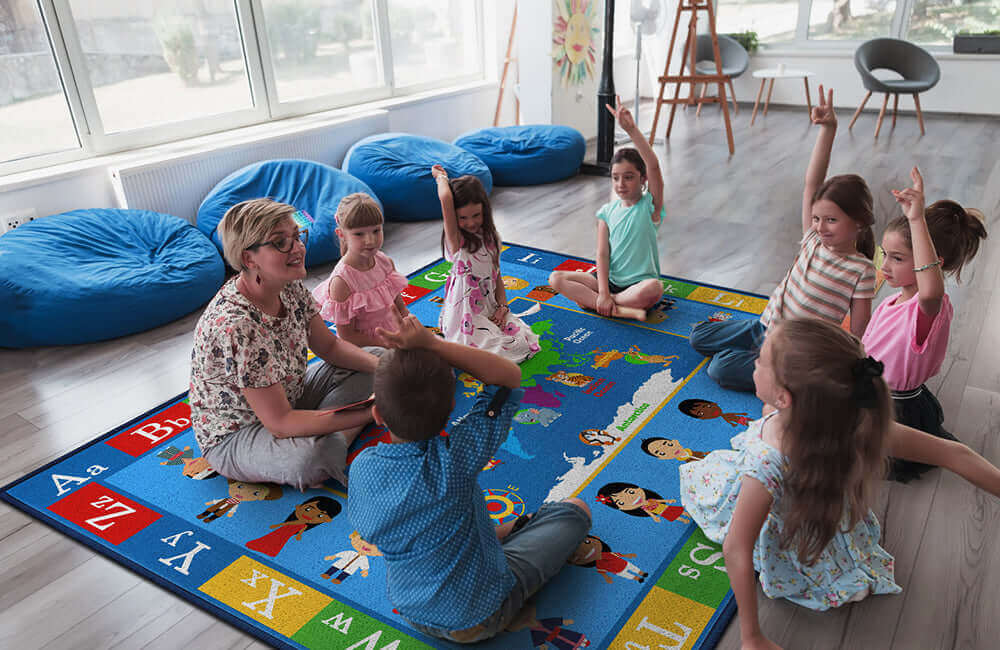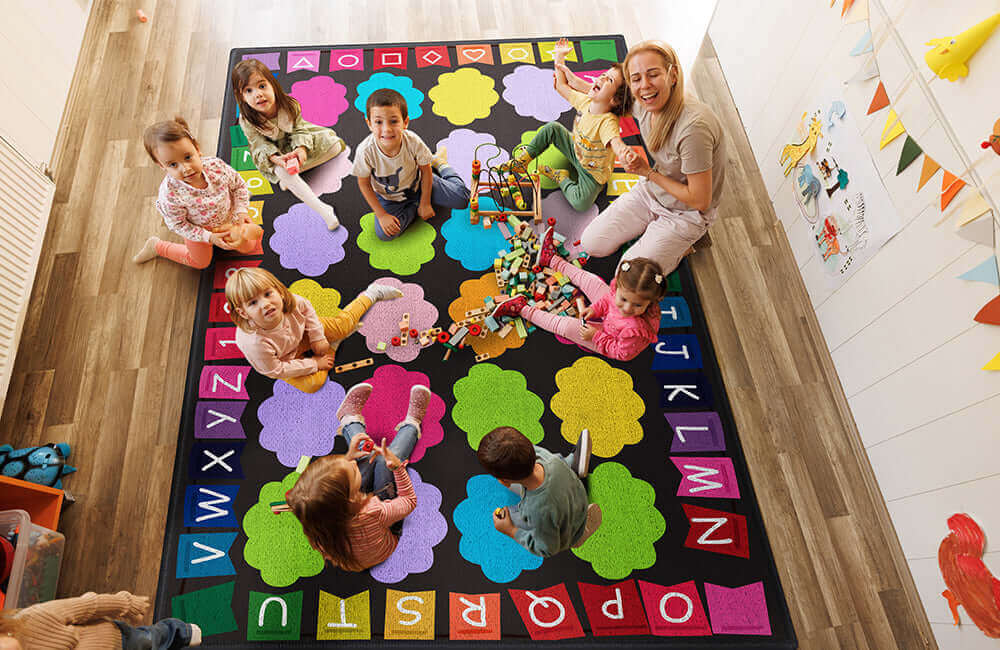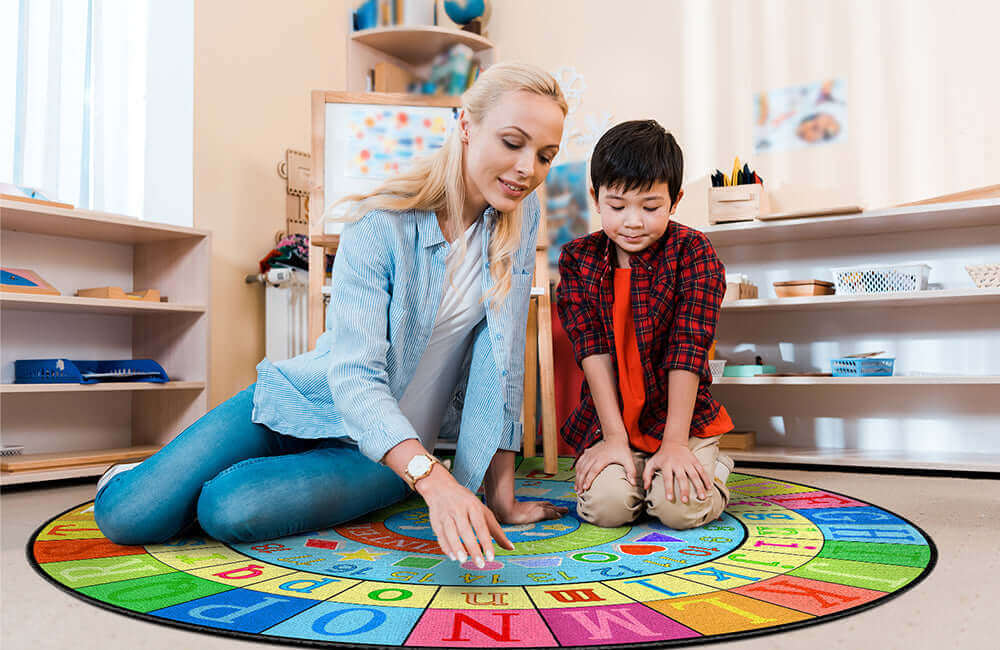Budget Considerations for Classroom Furniture
Before diving into specific furniture options, it's important to establish a clear budgeting strategy. According to Edutopia's article on classroom budgeting, the average teacher spends between $500-$1,000 of their own money on classroom supplies annually.
Furniture—especially classroom rugs often represents the largest potential expense in this category.
Developing a Furniture Budget Plan
- Prioritize Essential Items: Identify must-have pieces versus nice-to-have additions.
- Consider Long-Term Value: Factor in durability and versatility when calculating cost.
- Phase Purchases: Spread acquisitions across multiple budget cycles rather than all at once.
- Track Education Discounts: Many retailers offer significant educator discounts.
- Explore Shared Resources: Consider furniture sharing arrangements with other classrooms.
A strategic approach to budgeting—especially when choosing rugs by teaching style means understanding the total cost of ownership, not just the initial purchase price. As Wikipedia notes in its educational resources entry, "effective resource allocation often prioritizes durability and functionality over immediate cost savings."
Essential Furniture Elements
Every classroom needs certain furniture basics to function effectively. Here's how to approach these essentials affordably:
Student Seating
Seating typically consumes the largest portion of furniture budgets. Consider these affordable options:
- Stackable Chairs: These save storage space and often cost less than other options.
- Ball Chairs (Selective Use): Rather than replacing all seating, incorporate a few alternative seating options like stability balls with frames.
- Bench Seating: Can accommodate more students in less space than individual chairs.
Work Surfaces
Desks and tables provide essential work space for students:
- Adjustable-Height Tables: Though initially more expensive, their adaptability serves multiple grade levels and purposes over time.
- Group Tables: Larger shared tables often cost less per student than individual desks.
- Portable Writing Surfaces: Lap desks and clipboards offer flexible alternatives to traditional desks.
Storage Solutions
Effective storage keeps classrooms organized while maximizing space:
- Open Shelving: Simple shelf units cost significantly less than cabinets with doors.
- Plastic Bins: Durable and washable, these provide affordable compartmentalized storage.
- Repurposed Furniture: Old dressers or bookshelves from thrift stores can be revitalized for classroom use.
Teacher Workspace
An efficient teacher area doesn't require expensive furniture:
- Simple Desk Options: Basic computer desks often serve teachers' needs at lower costs than specialized teacher desks.
- Filing Systems: Vertical file folders in crates can replace expensive filing cabinets.
- Mobile Carts: Provide flexibility and often cost less than stationary teacher stations.
Affordable Furniture Sources
Finding budget-friendly classroom furniture requires knowing where to look:
Educational Surplus
Many districts and schools periodically sell or give away surplus furniture. According to Education Week's report on school resources, "surplus educational furniture often has significant useful life remaining despite cosmetic imperfections."
Online Marketplaces
Several online options specialize in affordable educational furniture:
- School Outfitters clearance sections
- Wayfair Education program
- Amazon Business for Education
Local Options
Don't overlook nearby sources:
- Business Closures: Offices often sell furniture at steep discounts when closing.
- Nonprofit Organizations: Some nonprofits collect and redistribute furniture to schools.
- Community Donations: Local businesses may donate gently used furniture for tax benefits.
Timing Purchases
Strategic timing can yield significant savings:
- End of fiscal year (usually June)
- After new school construction is completed
- January (mid-year budget adjustments often free up resources)
DIY and Upcycling Solutions
Creating and repurposing furniture can dramatically reduce costs while meeting classroom needs.
Upcycling Projects
Transform existing items into useful classroom furniture:
- Milk Crate Seating: Add cushions to crates or place circle time rugs on the floor to create inviting, low-cost group seating areas.
- Pallet Furniture: Wooden pallets can become reading benches, low tables, or display units.
- Tire Seating: Cleaned tires wrapped in rope or fabric make unique seating options.
Teacher-Built Solutions
Simple construction projects can yield custom furniture:
- PVC Pipe Reading Nooks: Create framework for quiet spaces with inexpensive piping.
- Plywood Reading Centers: Basic woodworking skills can produce reading corners at a fraction of commercial costs.
The Cult of Pedagogy blog notes that "teacher-created furniture solutions often better match specific classroom needs than commercial options, while costing significantly less."
Maximizing Furniture Longevity
Making affordable furniture last longer enhances its value:
Preventative Maintenance
Regular care extends furniture life:
- Implementing quarterly tightening of screws and bolts
- Adding felt pads to chair legs
- Teaching proper furniture use to students
Simple Repairs
Basic repair skills save replacement costs:
- Regluing loose joints
- Replacing damaged laminate with contact paper
- Reinforcing stress points with metal brackets
Protective Measures
Prevent damage proactively:
- Using pencil boxes to prevent desktop writing
- Adding clear contact paper to vulnerable surfaces
- Installing edge guards on table corners
Flexible and Multifunctional Options
Furniture that serves multiple purposes provides better value:
Convertible Furniture Solutions
These adaptable pieces serve multiple functions:
- Flip-top tables: Can be vertical for presentations or flat for group work
- Nesting tables: Store compactly but expand for projects
- Modular storage units: Reconfigure as needs change
Mobile Furniture
Adding mobility creates flexibility:
- Casters on bookshelves: Transform static storage into room dividers
- Rolling student seating: Facilitates quick transitions between configurations
- Portable whiteboards: Serve as both teaching tools and space dividers
According to Edutopia's classroom design research, "classrooms with flexible furniture arrangements show 15-25% higher engagement levels than those with fixed layouts."
Case Studies: Success on a Budget
Real-world examples demonstrate effective budget-friendly approaches:
Elementary Success: Lincoln Elementary
With just $1,200, a third-grade teacher transformed her classroom by:
- Purchasing six tables and adding large classroom rugs helped transform the space affordably while enhancing comfort for all 28 students.
- Adding floor cushions and lap desks ($200)
- Incorporating milk crate storage systems ($100)
- Installing tension rods with curtains to create separate spaces ($150)
- Adding casters to existing bookshelves ($150)
The result? A flexible learning environment that supports multiple teaching approaches while accommodating 28 students comfortably.
Middle School Approach: Westside Middle
A team of science teachers pooled resources to create shared furniture that rotates between classrooms:
- Mobile lab stations built from repurposed kitchen carts
- Standing workstations created from adjustable shelving units
- Demonstration tables made from reinforced folding tables
This approach reduced per-classroom costs by nearly 40%.
High School Innovation: Parkside High
An innovative art teacher created a studio environment for $800:
- Repurposed commercial drafting tables from a closed architecture firm
- Converted industrial spools into discussion tables
- Used concrete blocks and laminated plywood for durable work surfaces
Conclusion
Creating an affordable classroom doesn't mean sacrificing quality or educational effectiveness.
Through strategic sourcing, creative repurposing, and thoughtful purchasing decisions, educators can create learning environments that support student success without breaking budgets.
Remember that the most important aspect of classroom furniture isn't its cost—it's how well it supports your teaching style and your students' learning needs.
Often, the most budget-friendly solutions are also the most flexible, allowing you to adapt your space as educational approaches evolve.
For more ideas on creating effective learning environments on a budget, explore our related articles:




Leave a comment
This site is protected by hCaptcha and the hCaptcha Privacy Policy and Terms of Service apply.